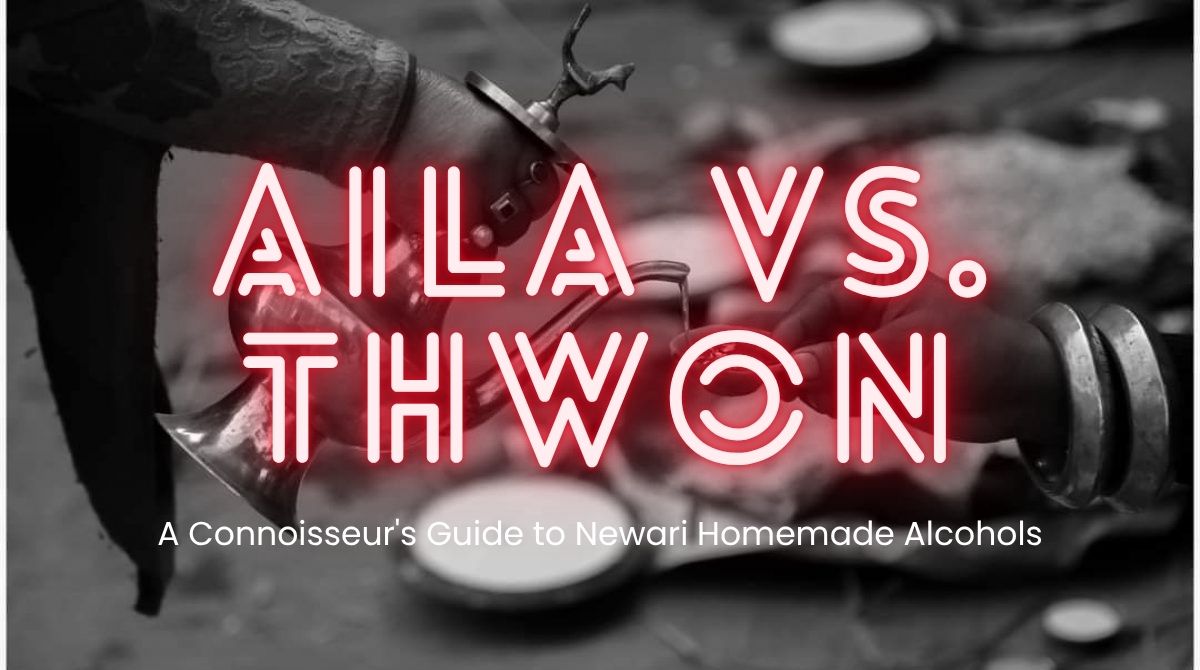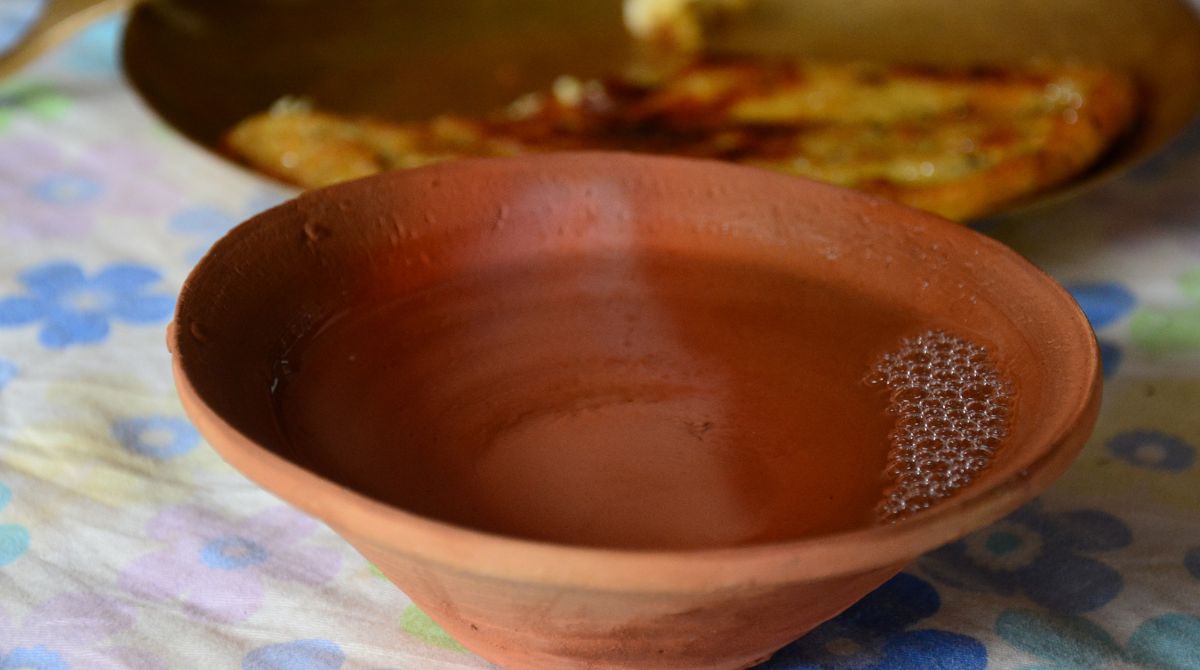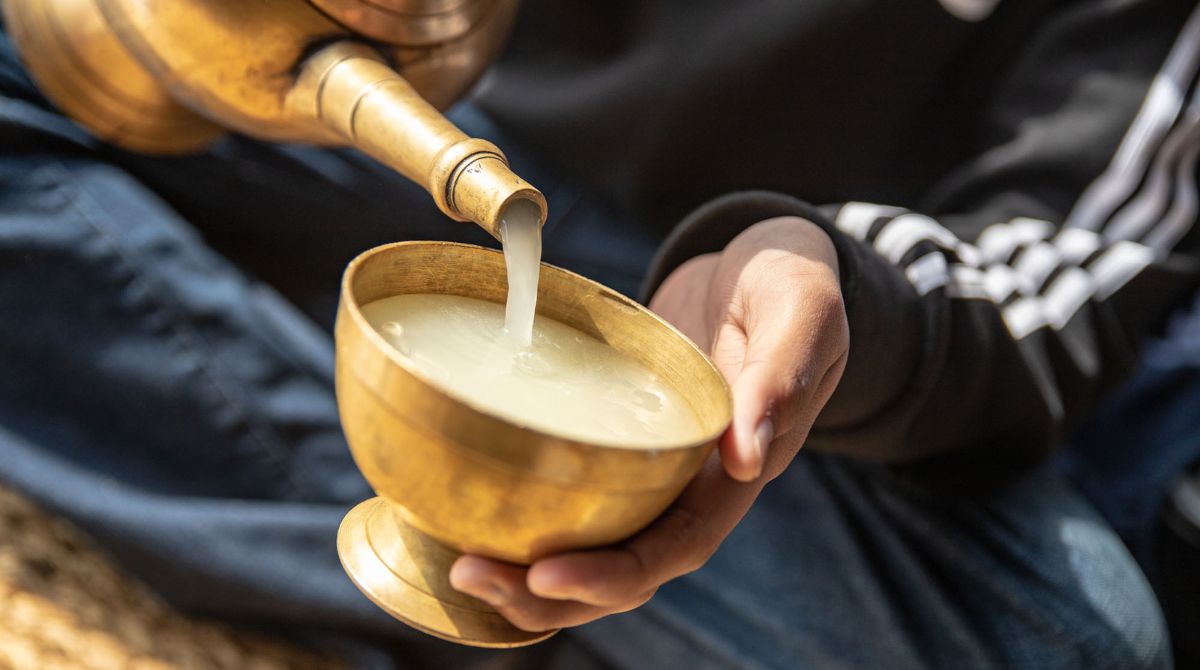Jwojalapa!
Step into the lively atmosphere of a Newar bhoj (feast). The air is thick with the aroma of spicy Chhoyela and the rhythmic sounds of conversation. In this vibrant scene, two traditional beverages flow, each holding a distinct and vital place in our culture. One is a clear, fiery spirit that is poured with dramatic flair, catching the light as it arcs through the air. The other is a milky, gentle brew, served humbly in small clay bowls.
These are Aila and Thwon, the two pillars of Newari homemade alcohols.
To the uninitiated, they might both just seem like “local drinks.” But to a Newar, they are as different as the sun and the moon. They serve different purposes, are made through different processes, and speak to different parts of our soul. This guide is your invitation to become a connoisseur. We will explore the Aila vs. Thwon dynamic, not to pick a winner, but to appreciate the unique genius of each.
Table of Contents
- More Than a Drink: The Sacred Role of Newari Homemade Alcohols
- Aila (अयला): The Spirit of Fire and Offerings
- Thwon (थ्वं): The Brew of Community and Comfort
- Aila vs. Thwon: A Connoisseur’s Head-to-Head Breakdown
- The Art of Serving and Drinking: A Guide to Proper Etiquette
1. More Than a Drink: The Sacred Role of Newari Homemade Alcohols
Before we compare them, it’s crucial to understand that in Newar culture, alcohol is not just for recreation. It is deeply integrated into our tantric traditions and rituals. Certain deities, particularly the powerful protector gods like Bhairava, are offered Aila as a sacred libation (prasad).
During many pujas, a small amount of Aila is offered to the gods first, then served to the participants. It acts as a purifying element, a medium that connects the physical world with the divine. It is a symbol of life force and energy. So, when you are offered a drink at a Newar home, you are often partaking in a tradition that is thousands of years old and steeped in spiritual significance.
2. Aila (अयला): The Spirit of Fire and Offerings
If Thwon is the gentle rhythm of the community, Aila is the flash of lightning.
What is it? Aila is a potent, clear, distilled spirit. It is made primarily from rice or millet (kodo), with millet-based Aila often considered to be of higher quality and smoother taste. It has been listed by CNN as one of the “50 most delicious drinks in the world,” a testament to its unique character.
The Process: Making Aila is a true art form, a science passed down through generations (usually by the women of the household). It involves fermentation of the grain, followed by distillation. This is done in a special set of clay and brass pots called a pottasi. The fermented mash is heated, the alcoholic steam rises, condenses on a cooler lid above, and drips down to be collected. This process concentrates the alcohol, resulting in a powerful spirit that can range from 40% to over 60% ABV.
Flavor and Strength: Aila has a sharp, fragrant, and slightly sweet aroma, reminiscent of sake or grappa but with its own distinct character. The taste is fiery and warming, and a good Aila goes down with a smooth heat, not a harsh burn.
The Cultural Role: Aila is the drink of the gods. It is the primary offering to deities like Bhairava, and it is the star of the show at feasts. It is served with a flourish from a traditional long-spouted brass pitcher called an anti. The server pours it from a great height into a small clay cup (salincha), creating a beautiful, unbroken stream that signifies purity and skill. It is a drink of power, celebration, and ritual.
3. Thwon (थ्वं): The Brew of Community and Comfort
Where Aila is fire, Thwon is earth. It is the gentle, nourishing brew that fuels long conversations and community gatherings.
What is it? Thwon is a fermented rice beer. It is milky in appearance, low in alcohol (typically 2-5% ABV), and has a much milder and more accessible flavor profile than Aila.
The Process: Thwon is brewed, not distilled. It is made by cooking rice, mixing it with a traditional starter culture called marcha (which contains yeast and molds), and allowing it to ferment in a clay pot for several days. The process is simpler and safer than distillation, and results in a less potent but equally important beverage.
Flavor and Strength: Thwon comes in two main varieties:
- Haku Thwon (Black Thwon): This is made with a specific type of red rice. It is not actually black, but has a slightly reddish or brownish hue. It is less filtered and has a tangy, slightly sour, and complex taste. It’s the more traditional and rustic version.
- Nhyapu Thwon (White Thwon): This is made from white rice, is more filtered, and is noticeably sweeter and smoother. It is often preferred by those new to the taste.
The Cultural Role: Thwon is the social lubricant. It is the drink you have during the day, the beverage served to quench thirst during a long bhoj. It is sipped slowly from large clay bowls called kholcha, passed around among friends. It is the drink of community, relaxation, and togetherness. It’s less about ritual fire and more about communal warmth.
4. Aila vs. Thwon: A Connoisseur’s Head-to-Head Breakdown
Let’s put them side-by-side to truly understand their differences. This is the heart of our exploration of Newari homemade alcohols.
| Feature | Aila (The Spirit) | Thwon (The Brew) |
| Process | Distilled | Fermented / Brewed |
| Ingredients | Rice or Millet (Kodo) | Rice (White or Red) |
| Strength | High (40-60%+ ABV) | Low (2-5% ABV) |
| Appearance | Crystal Clear | Milky, Opaque (White or Reddish) |
| Flavor | Fiery, fragrant, sharp, sometimes sweet | Mild, sweet (white) or tangy/sour (red) |
| Serving Vessel | Poured from an Anti into a small Salincha | Served in a larger clay bowl (Kholcha) |
| Cultural Role | Ritual offering, ceremonial drink, drink of power | Social drink, community beverage, thirst quencher |
| Analogy | A shot of high-proof whiskey or vodka | A glass of unfiltered beer or traditional cider |
5. The Art of Serving and Drinking: A Guide to Proper Etiquette
When you are offered these drinks, a little knowledge of etiquette goes a long way in showing respect.
- Receiving Aila: It is often served to you directly. Hold your small clay cup (salincha) with your right hand, or both hands. The server will pour it from a height. It is polite to take at least one sip. It is a strong drink, so sip it slowly!
- Drinking Thwon: Thwon is more casual. You might be given your own bowl, or you might share from a larger one. It is meant to be drunk more freely than Aila.
- The “Bottoms Up” Myth: There is no cultural requirement to finish your drink in one go. Drink at your own pace.
- Refusing Politely: If you do not drink alcohol, you can politely refuse by putting your hands together in a namaste gesture and saying “maf garnus, ma piyudina” (excuse me, I don’t drink). No one will be offended.
Conclusion: Two Sides of the Same Cultural Coin
So, in the great Aila vs. Thwon debate, who wins? The answer is: the culture wins.
They are not competitors; they are partners. They represent the duality of life itself—the sacred and the social, the fire and the earth, the intense ritual and the gentle communion. Aila sanctifies the ceremony, and Thwon nurtures the community. Together, this family of Newari homemade alcohols tells a complete story of our heritage. They are a testament to the resourcefulness and sophisticated craft of our ancestors.
The next time you are at a bhoj, I hope you see them not just as drinks, but as liquid history, each with its own story to tell.
Subhaaye! (Good wishes!)
Frequently Asked Questions (FAQs)
1. Which is stronger, Aila or Thwon?
Aila is significantly stronger. It is a distilled spirit, similar in strength to vodka or whiskey (40%+ ABV). Thwon is a fermented beer, similar in strength to a light beer (2-5% ABV).
2. Can I buy Aila or Thwon in stores in Nepal?
Generally, no. Authentic Aila and Thwon are homemade products. While some restaurants and bhattis (local eateries) make and sell them for consumption on-site, they are not typically bottled and sold commercially due to legal regulations on homemade alcohol production.
3. Is it legal to make these at home?
In Nepal, there are regulations regarding the production and sale of alcohol. While traditional, small-scale home production for personal or community consumption is a long-standing practice and generally tolerated, commercial production and sale without a license is illegal.
4. What foods pair best with Aila and Thwon?
Aila, with its sharp, fiery nature, is a perfect match for the rich, spicy, and oily foods of a Newari feast, like Chhoyela (spicy grilled meat), Takha (jellied meat), and fried items. Thwon, being milder and sweeter, is a pleasant accompaniment to the whole meal and is especially good for cooling the palate after a spicy bite.
5. What is the proper way to say “cheers” in Newari?
While there isn’t a direct, one-to-one translation for “cheers,” a common way to acknowledge the drink and the company is to simply raise your bowl slightly, make eye contact, and say Jwojalapa (greetings) or simply give a nod and a smile before sipping.



